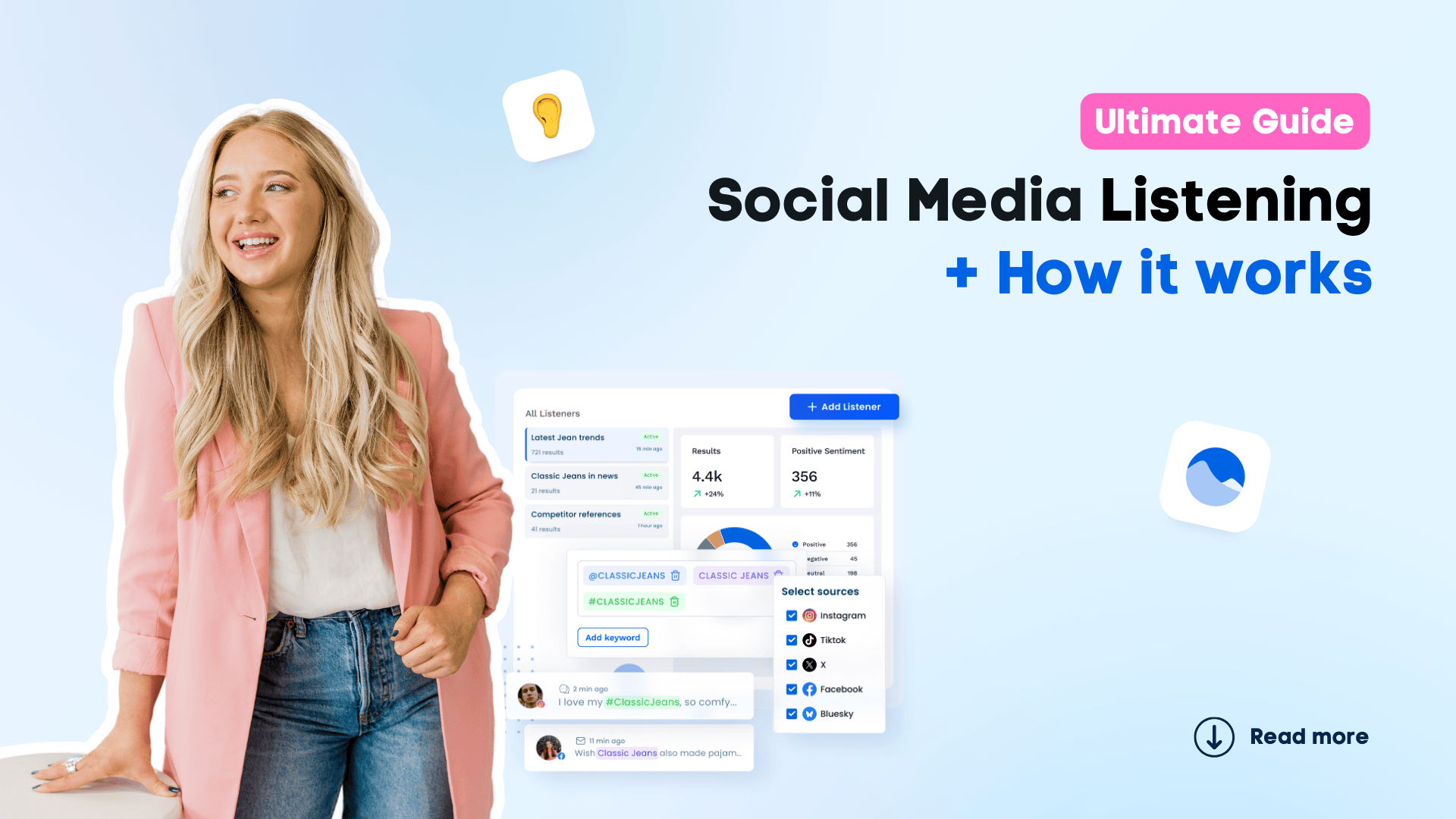Drowning in the noise of social media?
With countless mentions, comments, and hashtags flooding in daily, it’s easy to feel overwhelmed—especially if you manage multiple accounts.
But what if you could cut through the chaos and extract meaningful insights instead of just reacting to the noise?
That’s where social media listening comes in.
By tracking and analyzing online conversations, you can uncover valuable trends, understand your audience on a deeper level, and stay ahead of the competition.
A strong social listening strategy empowers you to make data-driven decisions, identify emerging opportunities, and enhance your brand’s online presence.
In this guide, we’ll break down everything you need to know about social media listening—how it works, why it matters, and how you can use it to turn overwhelming data into actionable insights.
Let’s dive in.
What you will learn
- What is social media listening?
- Why use social media listening?
- How does social media listening work?
- What are the types of data you can measure via social media listening?
- 8 Tips to develop your social media listening strategy
- How to use Vista Social to supercharge social media listening
- FAQs on social media listening
- Master the art of social media listening
What is social media listening?
Social media listening is the art of having your ear to the ground to hear the endless chatter happening online—but in a smart, strategic way.
It’s more than just tracking mentions of your clients’ brands or checking your notifications.
It’s about analyzing social data: what people say about your clients’ businesses, competitors, or industries across social channels such as Twitter, Instagram, and beyond.
Effective social listening helps you spot social media trends, understand customer sentiments, and jump into conversations that matter.
Essentially, it’s your gateway to help clients stay relevant by keeping your finger on the pulse of their audiences’ needs, wants, and frustrations.
Think of it as knowing what your clients’ audiences and potential customers want before they even say them.
Why use social media listening?
The benefits of social listening include the following.
Stay ahead of the game
Social media is a whirlwind of trends, and missing one can mean your clients falling behind their competitors.
Social media listening helps you catch emerging trends, viral moments, and industry buzz before they hit the mainstream.
By acting early, you can create social content or campaigns that position your clients’ brands as innovative and in-the-know, solidifying their reputations as leaders.
Manage brand reputation
Your clients’ brand reputations are constantly at stake in the public eye.
Social media listening lets you monitor mentions and sentiment in real time, so you can address concerns before they escalate into PR nightmares.
On the flip side, social listening also helps you capitalize on positive feedback, testimonials, or shoutouts to strengthen your clients’ brand credibility and showcase their stellar reputations.
Understand your audience better
Your clients’ audiences aren’t monoliths—they have diverse needs, preferences, and opinions.
Listening allows you to analyze what they love, hate, and wish for so you can create a social listening strategy and develop campaigns that speak directly to them.
It’s like having a direct line into their minds, helping you connect on a deeper, more meaningful level.
Learn from competitors
Ever wish you had an insider peek at your competitors’ playbook?
Social media listening can give you exactly that—without crossing any lines.
Analyzing competitor mentions, campaigns, and audience feedback, helps you identify what works for them or not.
Then, you can apply those insights to refine your strategy and help your clients stay a step ahead.
Measure marketing campaign impact
You can’t just launch your clients’ campaigns and hope for the best.
You need to track their real-time impact with social media listening.
See how your audience reacts, identify what’s resonating (and what’s not), and adjust on the fly to maximize the results of your social listening efforts.
It’s like having a live performance review for every social media marketing campaign you run.
Must read: Social Media Marketing for Agencies: w/ Tips & Tools
Discover collaboration opportunities
Social media listening helps you spot influencers, brand advocates, or power users already talking about your clients’ businesses, brands, or products.
Collaborating with these individuals can amplify your clients’ message and make their brands more authentic, especially since audiences trust recommendations from real people over traditional ads.
Make data driven decisions confidently
Forget guesswork and gut feelings—social media listening can give you hard, actionable data to inform your strategies.
Whether creating content, refining your client’s messaging, or choosing the latest social media trends to ride, the insights help ensure you and your clients make smart and impactful decisions.
Strengthen customer loyalty
Do you want to help your clients build an audience that sticks with them through thick and thin?
Show them that your clients are listening.
Leverage your social listening insights to acknowledge customer feedback, address concerns, and celebrate their wins to help your clients foster genuine connections.
Social listening also gives you good social engagement and tracking tools to engage authentically and leave a lasting impression.
Must read: Top 20 Social Media Engagement Tools to Boost Brand Visibility
How does social media listening work?
The social listening process often includes the key steps and methods below.
Data collection
Listening begins with tools that act like your digital ears, scouring social platforms such as Facebook, X (Twitter), Instagram, blogs, forums, and news outlets.
Must read: UNIQUE Facebook Captions: For Posts & Profile this 2025
The tools can capture mentions of specific keywords on social media networks, such as your clients’ brand names, products, industry trends, and other business-relevant terms.
Collecting data is the foundation—gathering all the noise so you can filter out the meaningful conversations.
Keyword monitoring
Keyword tracking is where your social listening strategy comes in.
You set the keywords or hashtags you and your clients want to track, such as their brand names, competitors’ names, or key industry terms.
Keyword monitoring is like casting a net in the right social media waters.
It helps ensure you’re not drowning in irrelevant data but catching the insights that matter most to your team and clients.
Sentiment analysis
Once the data is collected, sentiment analysis digs into the “feel” of your captured mentions.
Do people praise your clients’ products, vent frustrations, or are they just neutral?
Gauging the emotions behind the conversations on social media lets you assess how target audiences and customers perceive your clients’ brands and identify areas to improve or celebrate.
Trend identification
Social media is fast-paced, and trends can rise and fall in the blink of an eye.
Trend identification features within social media monitoring tools can analyze your clients’ data for patterns.
Must read: Top Social Media Monitoring Software for 2025
These crucial patterns can tell you whether a hashtag is gaining traction, including uncovering a recurring customer pain point or highlighting seasonal content themes.
Trend identification and insights equip you to stay agile and adapt to what’s hot, helping your clients stay ahead and competitive.
Competitor insights
Knowledge is power, and understanding what people say about your clients’ competitors can sharpen their edge.
Are their audiences buzzing about their new product feature?
Are your clients’ facing backlash for a campaign?
These insights help you fine-tune your strategy—avoiding common pitfalls or adopting and refining what’s working.
Report generation
After analyzing social media data, you can compile everything into digestible reports using social listening tools.
The reports can include visuals such as graphs, pie charts, or heatmaps that make pinpointing trends, audience sentiment, and engagement metrics at a glance quick and easy.
You’ll get insights without being overwhelmed.
Action planning
Insights are only valuable if you act on them.
Social media listening can give you the tools and insights you need to address PR crises, create content aligned with audience interests, and work with the right influencers.
It’s where all the gathered data is transformed into strategic moves that drive results.
What are the types of data you can measure via social media listening?
Listening allows you to measure various types of data to help you understand your audience and refine your social media strategy, including the following.
Brand mentions
Every time your client’s brand name pops up online—whether in a glowing review, a casual comment, or even a complaint—it’s an opportunity.
Listening helps you monitor social media mentions, tagged or untagged, so you can respond, engage, or simply stay informed.
Brand monitoring or tracking mentions give you a pulse on how often your clients’ brands are part of the digital conversation.
Sentiment analysis
Not all mentions are created equal.
Sentiment analysis digs deeper, examining the emotional tone behind what’s being said about your clients’ brands.
Are people excited about your client’s new product launch?
Or are they frustrated by a service issue?
Understanding these nuances helps you manage your clients’ reputations and tailor their responses to engage and provide satisfying interactions and experiences to their customers.
Share of voice
The Share of Voice measures how much space your clients’ brands occupy in industry conversations compared to their competitors.
For instance, if your clients dominate the social media chatter, you’re doing something right.
If not, share of voice helps you spot opportunities to step up your game and help clients gain more traction.
Trending topics
Staying relevant means keeping up with what’s trending.
Social media listening can identify hashtags, themes, or subjects gaining momentum in your clients’ industries.
Must read: Hashtag Analytics Guide: With Tips, Tools, and Strategies
Jumping on these trends early helps you create content or campaigns that position your clients’ brands as fresh and cutting edge.
Customer pain points
Most customers aren’t shy about voicing their frustrations online.
Social media listening helps you address these issues and improve your clients’ products or services by tracking recurring complaints or concerns.
Social listening can give you a direct line to customers’ unfiltered feedback.
Competitor mentions
Social media listening can track mentions of your clients’ competitors.
It can give you a behind-the-scenes look at what’s working for them and where they fall short.
You can leverage this intel to inspire your strategies and help your clients stand out across online and social media channels.
Engagement metrics
Besides mentions, social listening tools can track and measure engagement metrics such as likes, shares, comments, and other interactions.
The tools can show how well certain social media posts or topics resonate with your clients’ audiences.
The data helps you determine what content strategies drive meaningful engagement.
Audience insights
Social media listening collects demographic and behavioral data about your clients’ audiences, like age, location, and interests.
Understanding who they are makes it easier to tailor your content and campaigns to meet their needs.
The more your clients’ posts and social marketing efforts address their audiences’ needs, the more likely they drive engagement.
Industry buzz
The broader conversations happening in your clients’ industries can be just as important as brand-specific chatter.
Tracking industry buzz, allows you to spot emerging trends, help clients stay relevant, and find opportunities to position their brands as experts in the fields.
Campaign impact
Launching a campaign is only the first step.
Social media listening can measure your client’s campaign performance in real time by tracking reactions, sentiment shifts, and overall reach.
These insights can help you tweak your efforts on the fly and maximize results for clients.
8 Tips to develop your social media listening strategy
Develop an effective strategy using the time-tested social listening tips below.
1. Set clear goals
Before diving into social media listening, be crystal clear about your clients’ and team’s objectives.
Do you want to track customer sentiment, analyze competitor activity, or identify trending topics?
Identifying your social media listening goals helps you focus on the data that matters most and ensures your efforts align with your clients’ broader online marketing strategies.
2. Identify key social media platforms
Your clients’ audiences are not active on every platform, so they shouldn’t be either since this can lead to wasted resources and efforts.
Prioritize the social channels or sites where your clients’ target markets are most engaged.
Must read: Top 20+ Social Media Sites to Promote Your Clients [2025]
For instance, if your clients are targeting a younger audience, focus on Instagram or TikTok.
If your clients are in B2B marketing, LinkedIn is your playground.
3. Set target keywords
Think of keywords as the breadcrumbs leading you to valuable insights.
Track your clients’ brand names, competitors’ names, industry-specific terms, trending hashtags, and even common misspellings of their products.
The more comprehensive your keyword list, the richer your findings will likely be.
4. Leverage the right tools
Not all social listening tools are created equal.
Choose one that suits your team and clients’ unique needs.
The right social media listening tool can do the heavy lifting, saving you time while delivering accurate, actionable data crucial for boosting customer satisfaction and improving results.
5. Join conversations
Social media listening isn’t a spectator sport.
When you spot an opportunity to connect—whether responding to feedback or joining a trending conversation—jump in.
Engagement shows audiences that your clients listen, humanizing their brands and helping them form stronger customer connections and relationships.
6. Refine your campaigns
Your social listening data is a goldmine for campaign optimization.
If a certain trend or topic is catching fire, adapt your clients’ content to reflect it.
Similarly, if your audience isn’t responding as expected, tweak your client’s messaging based on your gathered insights.
7. Analyze trends regularly
Trends don’t wait—they come and go in the blink of an eye.
Regularly analyze trends so you can pivot your strategy to keep your clients’ brands relevant on social media.
Whether it’s a hashtag gaining more users or a recurring customer pain point, staying on top of trends helps keep your clients competitive.
8. Measure and optimize
Track the effectiveness of your social listening efforts.
Are you seeing improved engagement, a better understanding of audience sentiment, or more successful campaigns?
Use this feedback to fine-tune your approach and ensure your strategy evolves over time so they keep working for your clients.
How to use Vista Social to supercharge social media listening
Implementing your social listening strategy can be efficient and effective with Vista Social.
The platform offers sophisticated social listening tools to track online conversations and uncover actionable insights to take your clients to the top of the social media food chain.
Vista Social’s core social media listening features are easy to use.
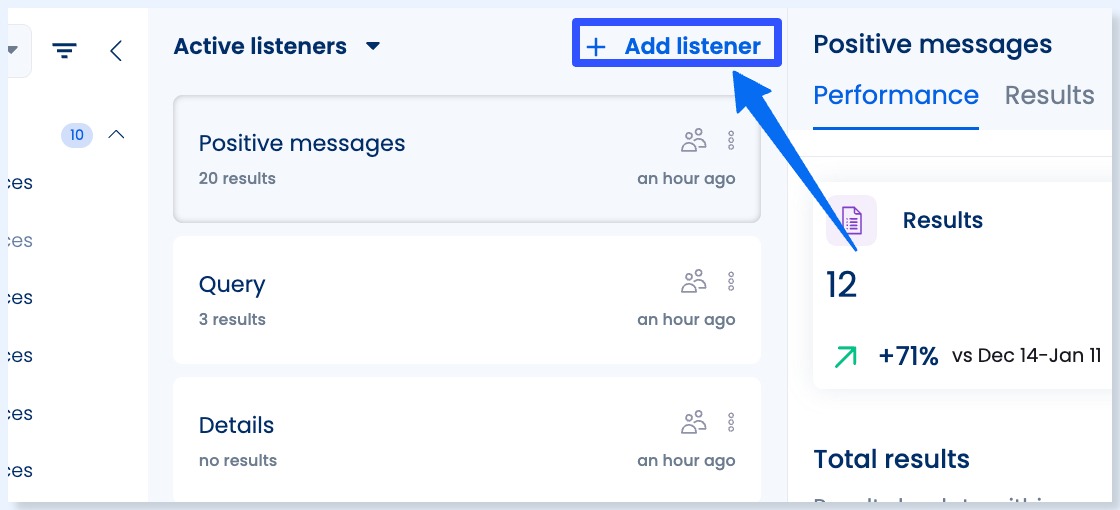
The platform lets you set up Listeners that will track data across various online sources (review sites, news, social networks, etc.) based on your specific keywords or queries.
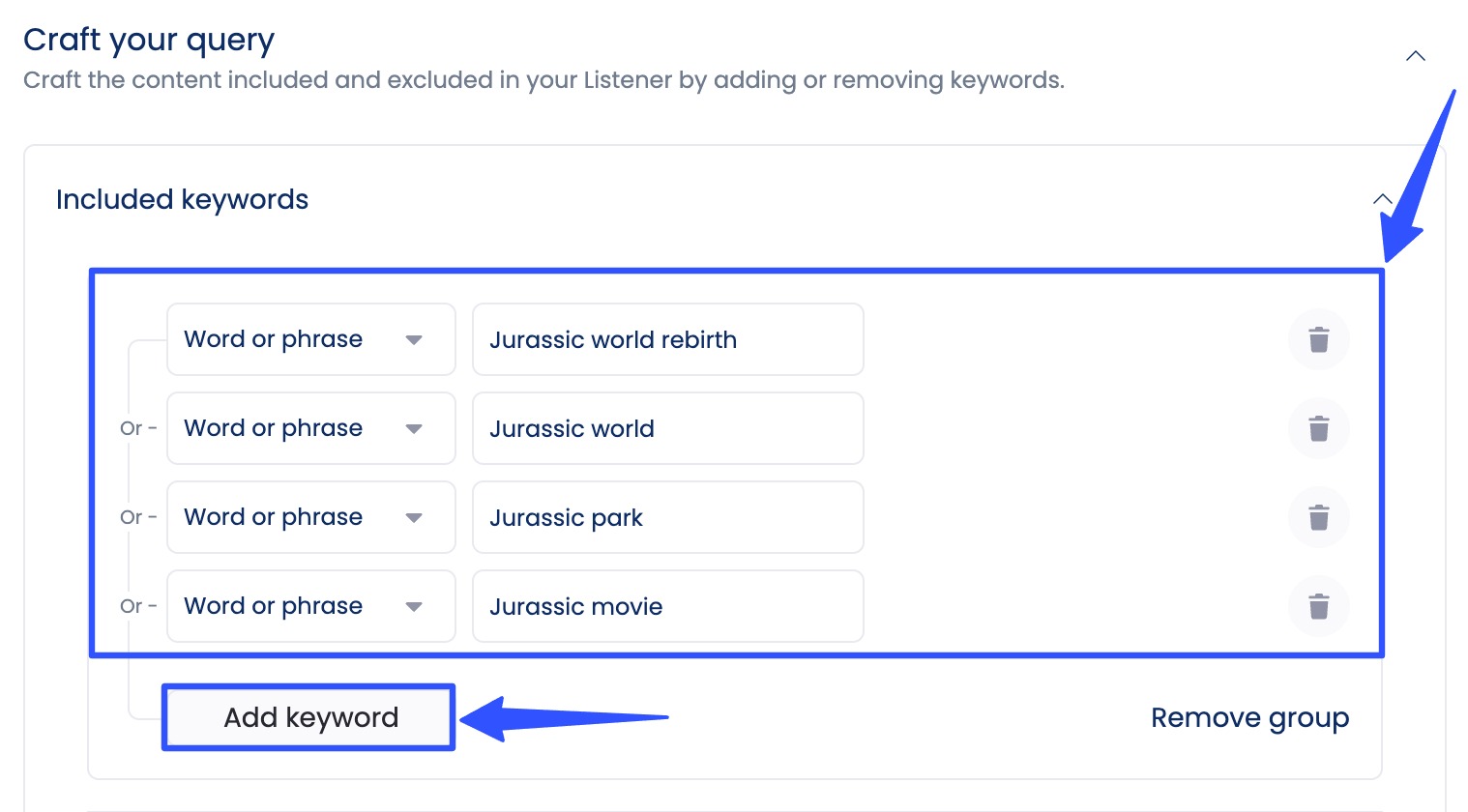
You can create phrase or word groups and pick whether to make all or specific keywords appear on your Listener or exclude results containing keywords you don’t want.

The social media conversations pulled through your Listeners are automatically tagged based on their sentiment (positive, negative, neutral, or mixed), and you can filter them by sentiment.

You can also apply optional filters to refine your Listeners further, such as by location or language.

Everything is in one dashboard for easy accessing and management.
You’ll see all the connected social media profiles, Active Listeners and their names, the list of results, and overall Listener performance.
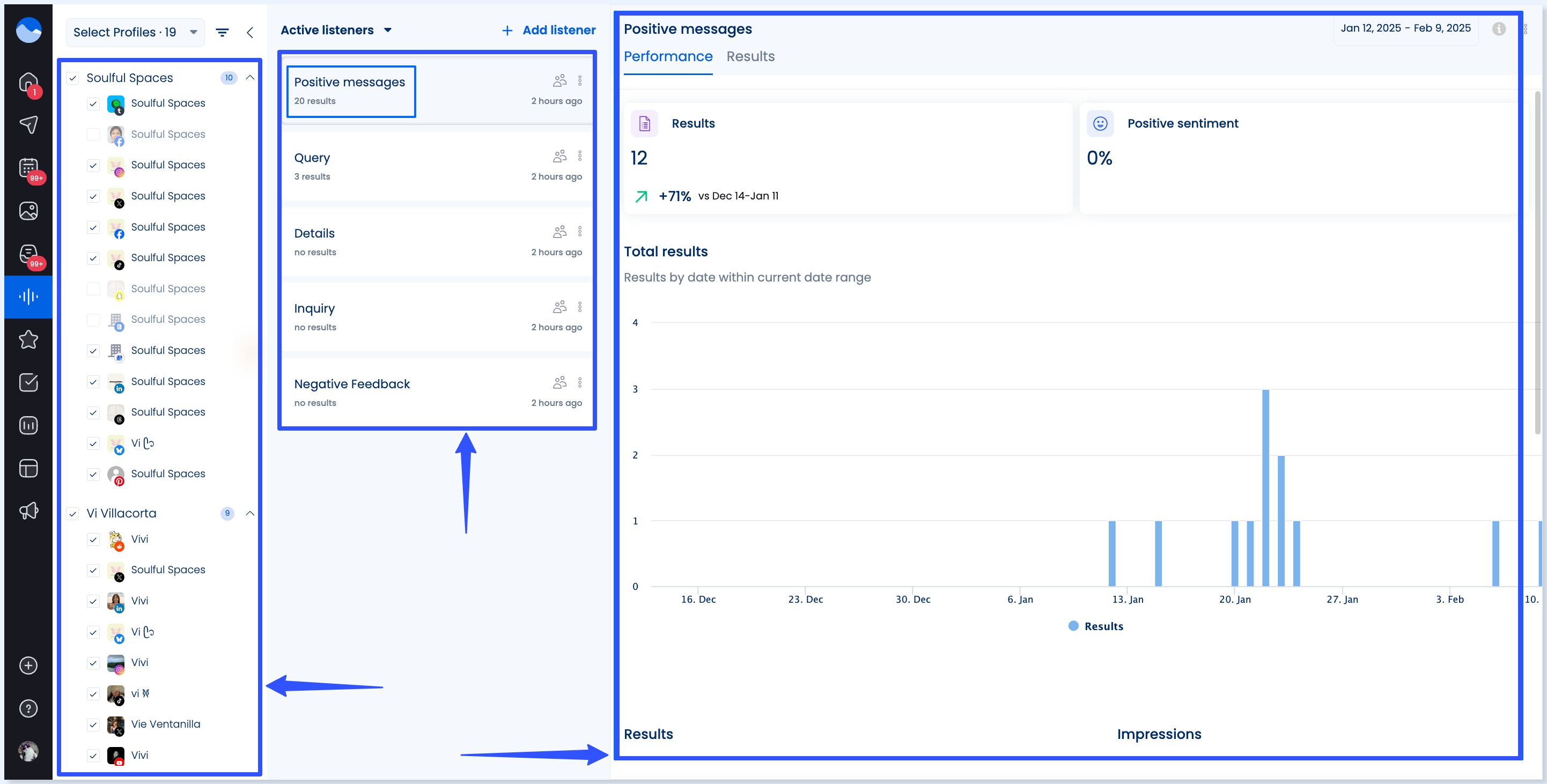
Select the specific period of the Listener performance you want so see by clicking the date on the upper right corner and choosing the report dates.
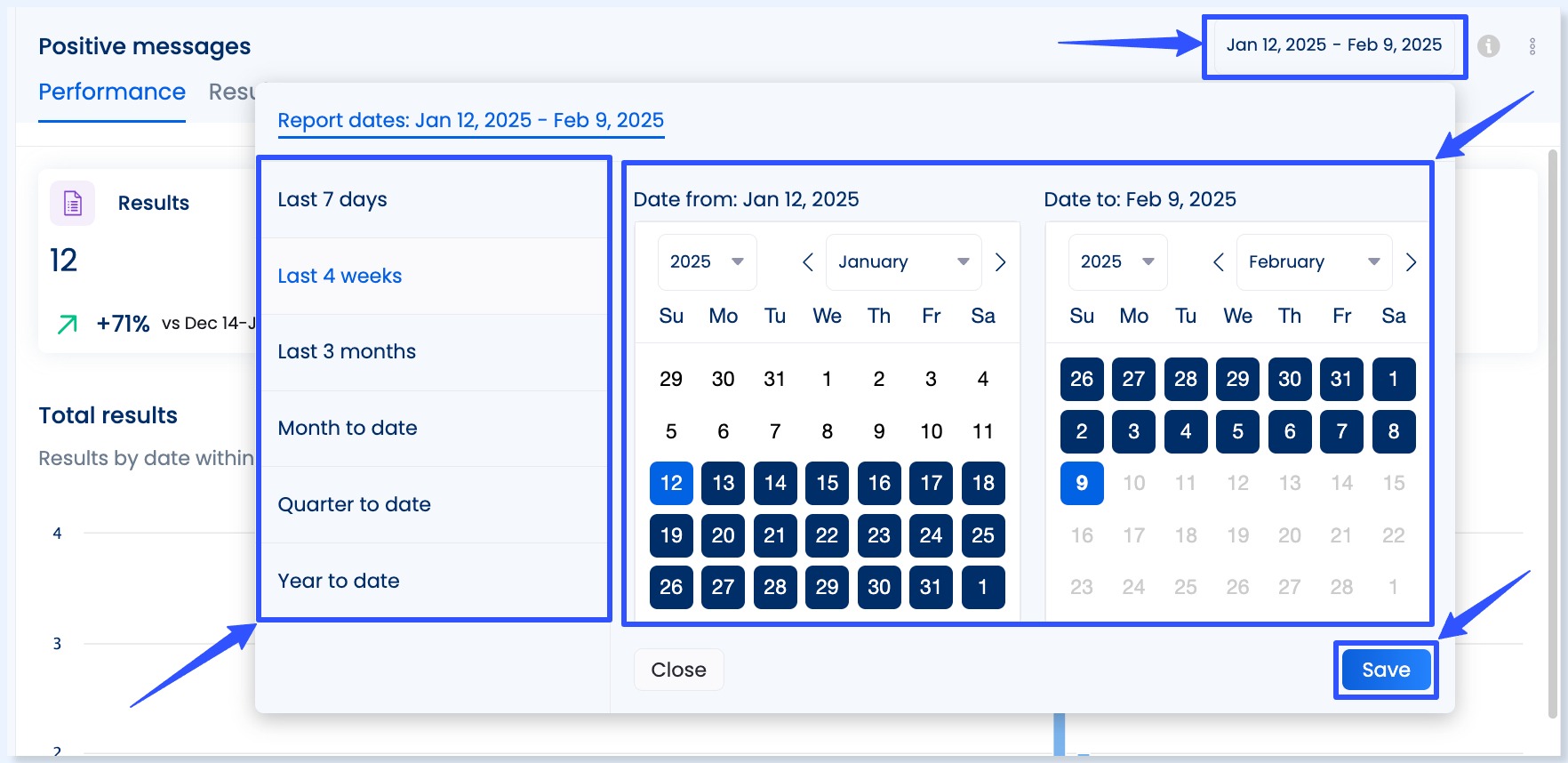
To download your report, click the three dots icon and select Export.
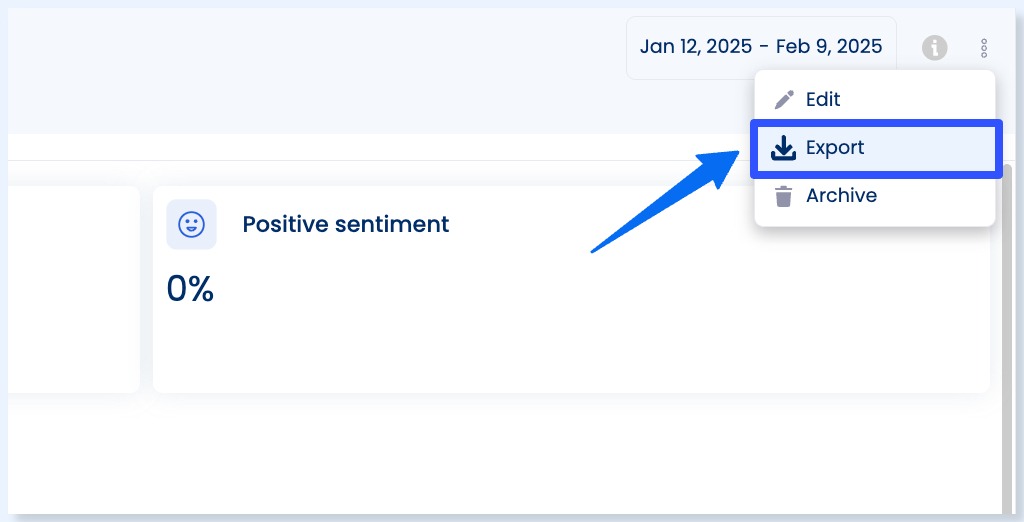
Another handy Vista Social listening feature is that it lets you reply to conversations in your Listener.
Click on the social conversation in your Listener and you’ll be directed to the actual messages in the social media platform’s inbox or post containing the comment.
From here, you can respond to the message, comment, or review (if the feature for that network is supported).

Don’t miss out on Vista Social’s other social media listening tools, such as the following.
- Personalized notifications for timely response
- Detailed sentiment analysis
- Consumer research
- Sentiment and trend analysis
- Competitor comparison reports
- Trend identification tools
- Sentiment research
- Campaign analysis
- Industry analysis
- Consumer feedback tracking and insights into the customer experience
Vista Social’s main social media management tools include the following.
Must read: 10+ Top Social Media Calendar Tools for 2025: w/ Pros & Cons
- Collaborative social media content calendar
- Social media scheduling and auto publishing, including post queueing and bulk scheduling
- Audience and community management via the smart Social Inbox
- Review management
- Social media analytics tools and reporting options
- Automated, multi or single-stage post approval workflows
- Canva integration
- Employee advocacy
- Link in bio tool with Vista Page, a customizable and brandable landing page and micro website
Must read: 15 Best Link in Bio Tools for Agencies & Brands for 2025
FAQs on social media listening
What is the difference between social listening and social monitoring?
Social media monitoring and social listening are not the same.
Social monitoring focuses on tracking mentions and responding to them.
On the other hand, social listening analyzes the broader context, such as sentiment and trends, to inform your strategy.
What are the challenges in social media listening?
Some of the common pitfalls of social listening include managing vast amounts of data, distinguishing genuine feedback from noise, handling diverse languages, and ensuring ethical data usage.
How can social media listening improve your customer service?
By identifying customer pain points and feedback in real-time, your clients can address issues promptly, enhance customer satisfaction, and build stronger and lasting consumer relationships that lead to social media success.
Can small businesses benefit from social media listening?
Yes.
Social media listening helps small businesses understand their local audience, track competitor activity, and find opportunities for growth, even with limited resources.
Master the art of social media listening
Harnessing the power of social listening to get significant results doesn’t happen in a snap.
However, knowing the ins and outs, top tips, and best social media tools can put your listening efforts on the path to success.
Turn your strategy into an effective social media tactic by using the right tool with robust listening features.
Get started with social media management Vista Social by creating your account now.
